|
|
|
Welcome to the Hung Liu Studio Newsletter, Spring 2013.
Summoning Ghosts: The Art of Hung Liu, at the Oakland Museum of California, is presently on view. It has been extremely well received by both the public and the press. Attendance is great, and the accompanying exhibition catalogue, published by the museum and the University of California Press, is flying off the bookstore shelves. We enjoy eating brunch at the Blue Oak Cafe, in the museum, and wandering over to the gallery to see the paintings and observe the audience. Many of these paintings we haven't seen in decades. Seeing them together is a compelling experience, since most of them - having been painted at different times in the artist's career - have never been together before. A retrospective is often the only chance an artist will get. A story bigger than her memory of painting arises from all of the paintings together. She sees her story - her stories - told in waves that wash up from the past before breaking on the strange rocks of the present and rolling back. Some deluge the senses, others lap at the heart. After so many decades of work, and of living a life that foretells the work and also makes it possible, the experience of seeing these canvases and drawings and their images and drips and circles all in one place is truly humbling. Gratitude for having had the opportunity is all that's left.
Enjoy the newsletter!
|
|
|
|
Exhibitions
Summoning Ghosts: The Art of Hung Liu
Oakland Museum of California March 16 - June 30, 2013
The exhibition
Summoning Ghosts: The Art of Hung Liu is the first comprehensive survey of America's most prominent Chinese artist. Featuring approximately 80 paintings, as well as such personal ephemera as photographs, sketch books, and informal painting studies from private and public collections, the exhibition celebrates Liu's career accomplishments and includes work completed in China before the artist arrived in the United States.

Hung Liu's life experience, complex personal history, understanding of female identity, sensitivity to immigrant culture, and vigorous powers of expression have made her a one-of-a-kind artist. Ai Weiwei November 2012
 | |
Resident Alien, 1988, San Jose Museum of Art
|
Though deeply rooted in Chinese culture and history, Hung Liu's works - paintings, multiples, photographs, videos, and installations - express the fundamental psychic and global displacement of her subjects, which have included turn-of-the-century Chinese prostitutes, peasant laborers, street performers, soldiers and prisoners, war refugees, migrants, and even Chinese pioneers in America. Gathered primarily from historical photographs, these subjects bear witness to a liminal perspective that challenges the boundaries between collective memory and personal history, between photographic anonymity and painterly portraiture, between feminine exoticism and female strength, between an ancient culture and a new world, and between political ideology and individual will. Liu's paintings, which are often large, drippy, washed with linseed oil, and layered with passages from traditional Chinese painting and calligraphy, can be seen as critiques of the rigid academicism of the Socialist Realist style in which she was trained. The result is a fresh, improvisational kind of history painting. Liu has written that she wants "both to preserve and destroy the image." Indeed, much of the meaning of her canvases comes from the way the washes and drips dissolve the photo-based images, working to liberate the cultural and personal narratives fixed - and often concealed - in the photographic instant. In effect, Liu turns old photographs into new paintings. Exhibition Views ... 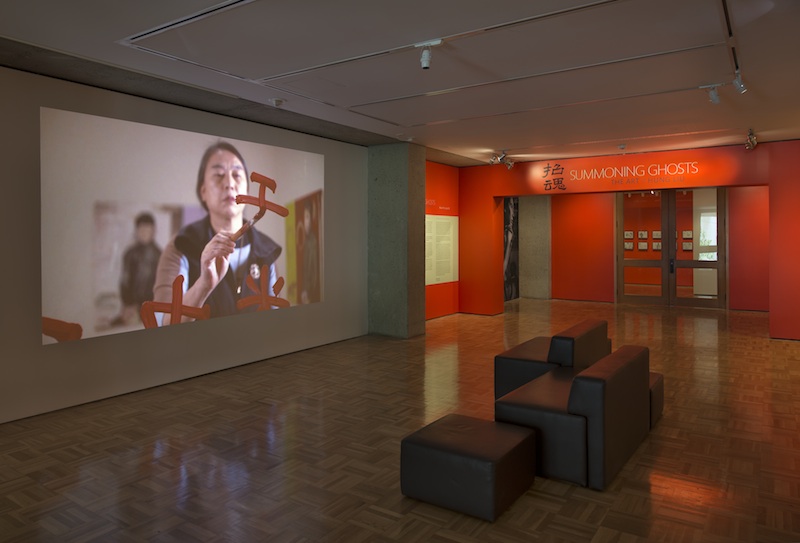 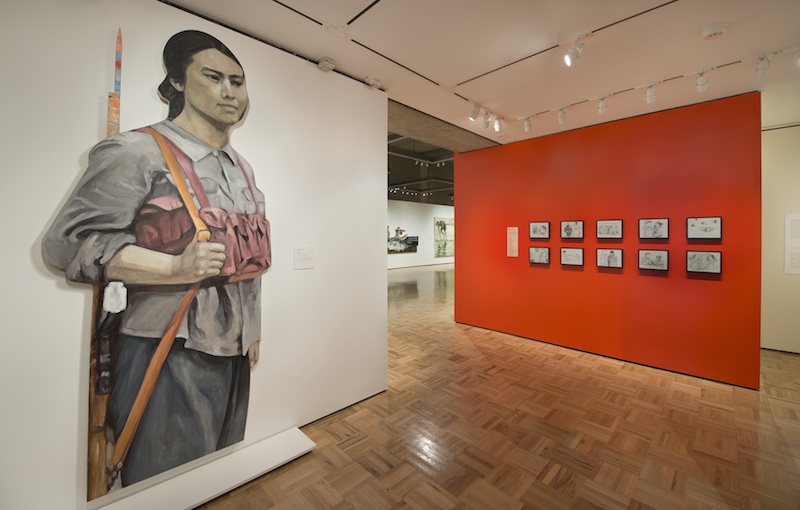
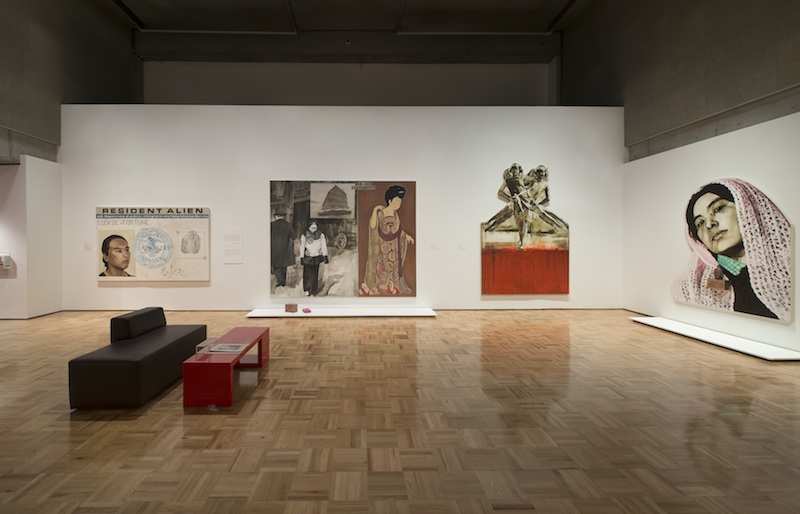



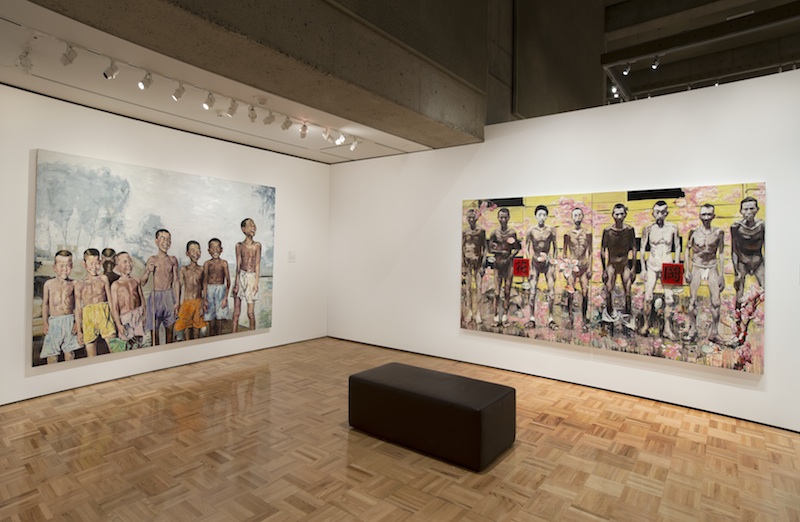
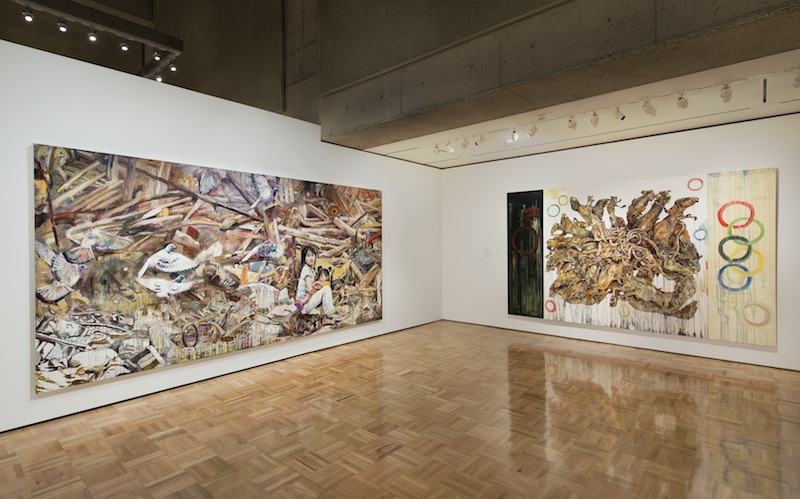

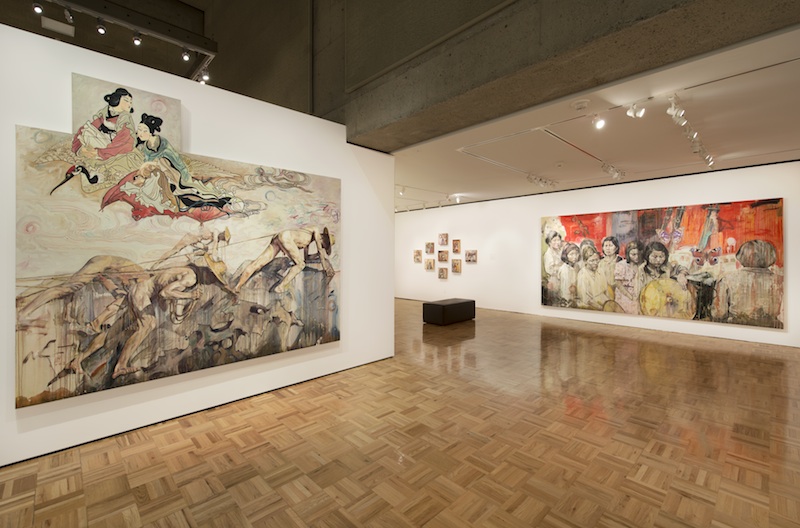
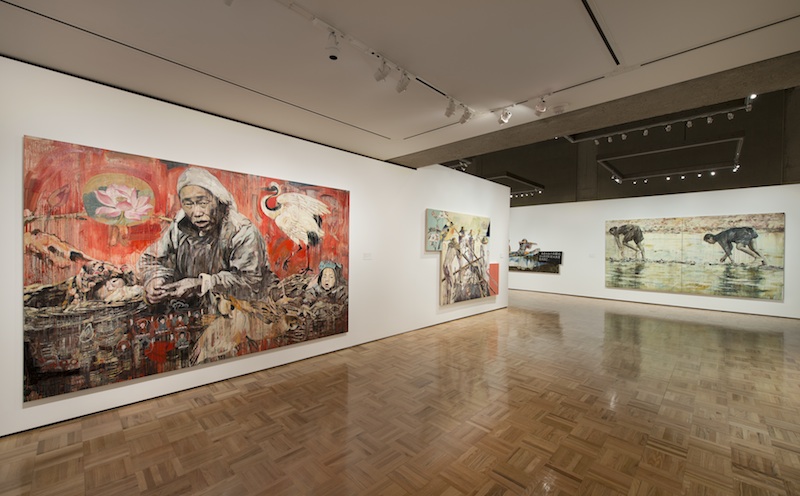

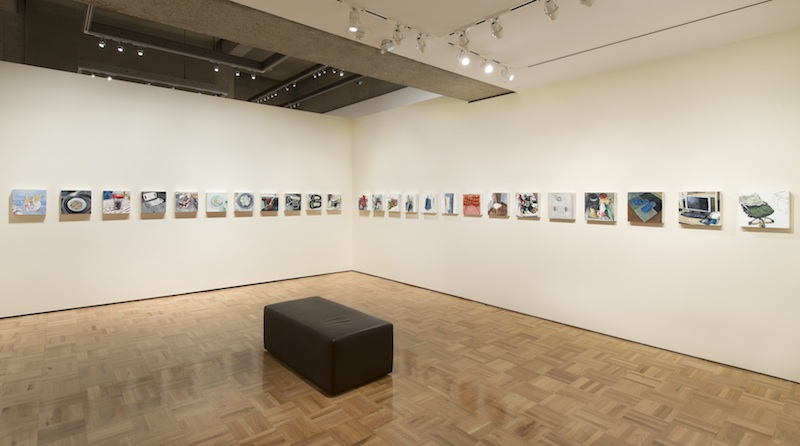
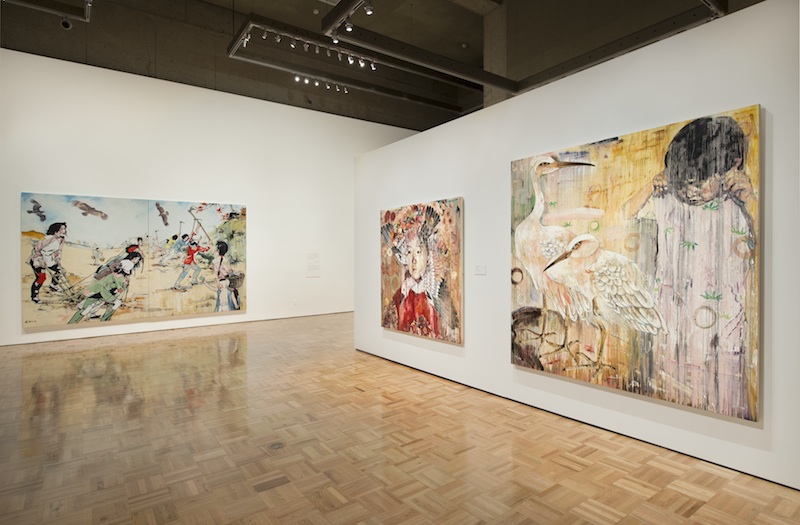


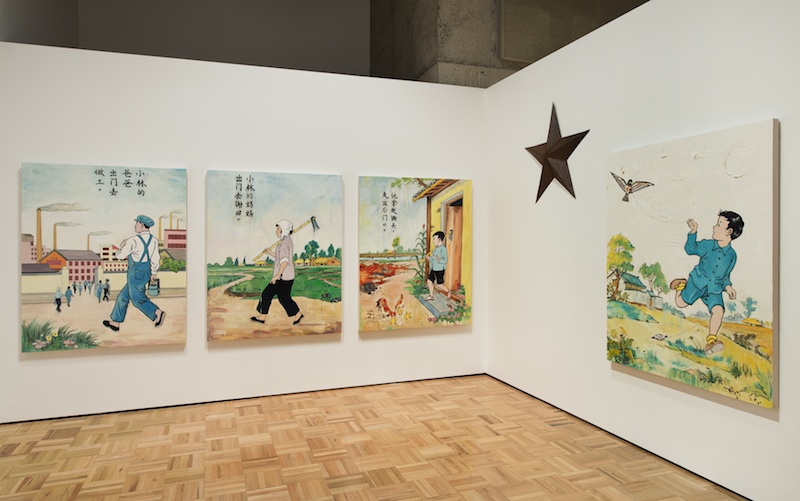
|
|
Mills College Art Museum
January 23 - March 17, 2013
Hung Liu is known as a painter but has also created large-scale installations throughout her career. This exhibition - Offerings - presented a rare opportunity to experience two of the Oakland-based artist�s most significant installations: Jiu Jin Shan (Old Gold Mountain) (1994) and Tai Cang: Great Granary (2008). The exhibition, which ended in March, examined the themes of memory,
history, and cultural identity through works that navigated between emigration (leaving a familiar place) and immigration (arriving at a new location). Accompanied by related paintings and prints, Jiu Jin Shan and Tai Cang served as memorials, or offerings, to the past while acknowledging the rapidly changing cultural dynamics of contemporary China and the world.

Tai Cang (Great Granary) 2008 - 2013 Tai Cang (Great Granary) consists of two major components; the first is a reinterpretation of the mural Liu painted at the Central Academy of Fine Art (CAFA) in Beijing, China. Entitled Music of the Great Earth, the work was an homage to the recent excavation of ancient bronze bells. The mural was destroyed when the CAFA property was sold and demolished. Liu's reconstructed mural, Music of the Great Earth II, serves as a kind of palimpsest, using digital images from the destroyed original overlaid with new elements pulled from across her later body of work. 
The second part of the installation consists of a selection of 34 antique dou, a traditional Chinese food container and unit of measure. Each dou contains a grain, cereal, or bean from a different region of China. As a country, China is composed of 34 provinces and special administrative or autonomous regions, and Liu arranged the vessels to form a map of China on the gallery floor. The connection to food as sustenance, community, and economic prosperity is echoed in the history of Liu's accompanying mural, as the original Music of the Great Earth was created specifically for the foreign student dining hall at CAFA. While the first mural was destroyed when the Academy moved to a new location, surviving line drawings and photographs of the work provided Liu with materials to revisit the past. Nearly forty feet in length, Music of the Great Earth II echoes Liu's initial references to ancient music and dance inspired by the Warring States bells, an ancient musical instrument consisting of 65 bronze bells known as a bianzhong, which was discovered in the fifth-century BC tomb of Marquis Yi of Zeng in Sui County, Hubei Province, China three years before Liu painted her original mural. The first version of the work served as reaction against the politically driven socialist realism of Chinese murals during the Cultural Revolution. Instead, Liu championed a more formal exploration of real and imaginary images to create a mass of rhythmic lines and forms. Liu conscripted two concepts from ancient Chinese philosophy, the idea of the Five Sounds (the ancient pentatonic scale of gong-shang-jue-zhi-yu that was exemplified by the discovery of the bianzhong), as well as the imagery of the Four Mythic Beasts (the Azure Dragon of the East, the Vermillion Bird of the South, the White Tiger of the West, and the Black Tortoise of the North), who guard the four corners of the world, with China as the center point. These themes remain in Music of the Great Earth II, but take on new meaning through the addition of personal references.
In her new iteration, Liu reworked the original mural's imagery, keeping the groups of dancing men and exotic women playing musical instruments. For this new version, however, she incorporated elements and fragments from significant pieces throughout her career. In revisiting Music of the Great Earth, Liu was not attempting to faithfully recreate the lost mural, but rather, to examine her passage between past and present and the ways distance and time both inform and change perspectives.
Jiu Jin Shang (Old Gold Mountain) 1994-2013
In the installation Jiu Jin Shan (Old Gold Mountain), two hundred thousand fortune cookies create a symbolic gold mountain that sits atop a crossing of railroad tracks. The junction where the tracks meet serves as a visual metaphor of the cultural intersection of East and West as well as a terminus for the dreams of many Chinese immigrants who perished during the construction of the transcontinental railroad. Liu references not only the history of Chinese laborers who built the railroads for the West Coast Gold Rush, but also the specific history of San Francisco. The city was named Old Gold Mountain by Chinese migrant workers in the nineteenth century as an expression of the hope of finding prosperity in the new world. Individually, the fortune cookies, invented in San Francisco by a Japanese entrepreneur in the early twentieth century, become substitutes for gold nuggets, and together represent the traditional Chinese burial mounds of Liu's Manchurian relatives.
 | |
Time Capsule, 2000
|
Haunting: A Performance by Molissa Fenley and Peiling Kao ... a response to Hung Liu's installation Mills College Art Museum March 16 - 18, 2013  | | Molissa Fenley & Peiling Kao performing Haunting, March 18, 2013. |
|
|
Friends
 | |
With Governor Jerry Brown
|
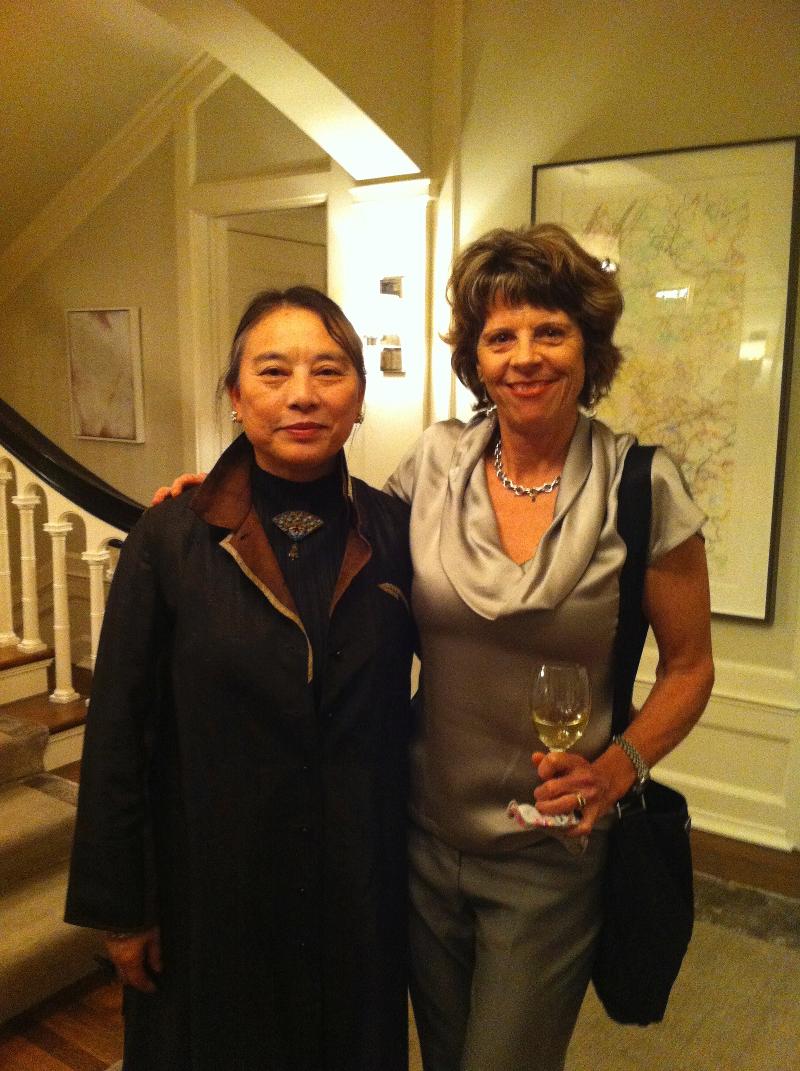 | |
With Quinn Delany
|
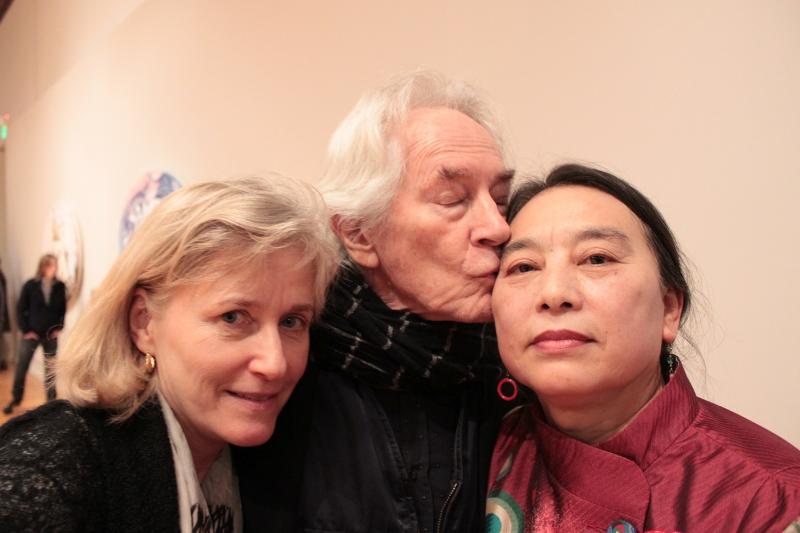 | |
With Amy Evans McLure and Michael McLure
|
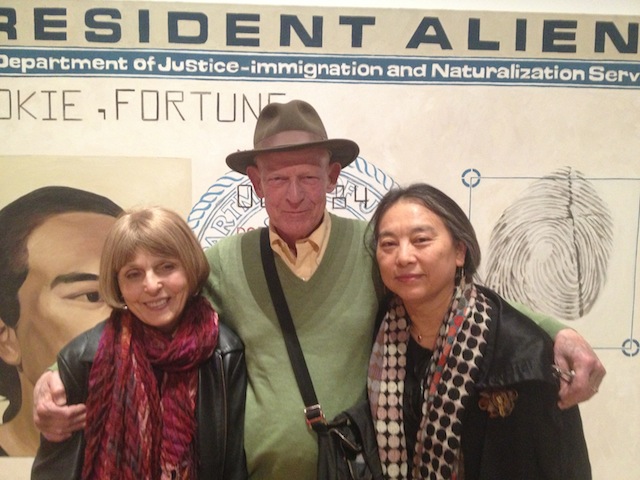 | |
With Connie Lewallen & Bill Berkson
|
 | |
With Jeff Kelley, Bill Fox, William Wiley, John Mason, & Vernita Mason
|
 | |
With Larry Rinder, Ann Hatch, & Paul Discoe
|
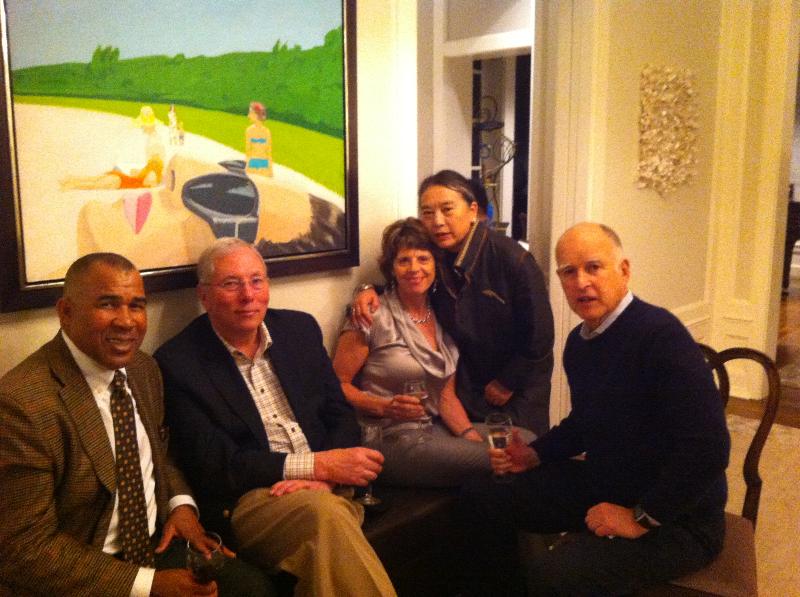 | |
With Wayne Jordan, Blair Hull, Quinn Delany, & Jerry Brown
|
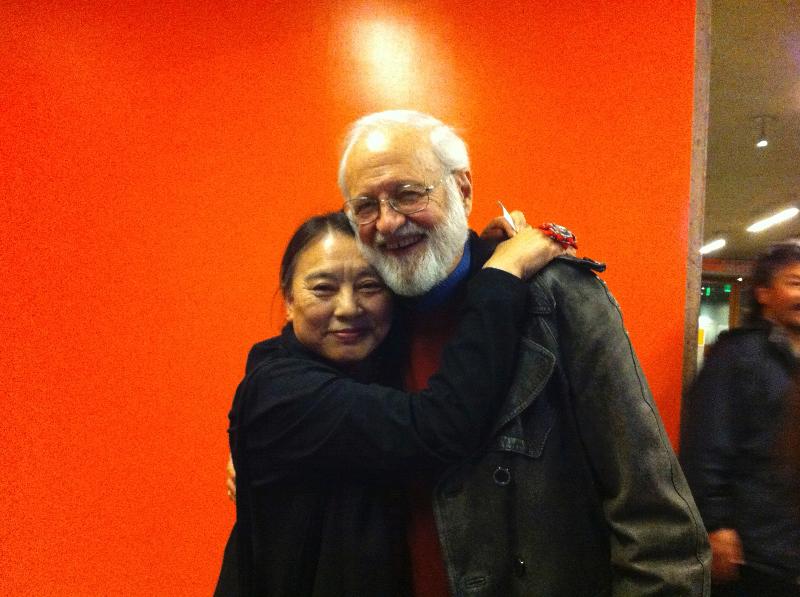 | |
With Jim Melchert
|
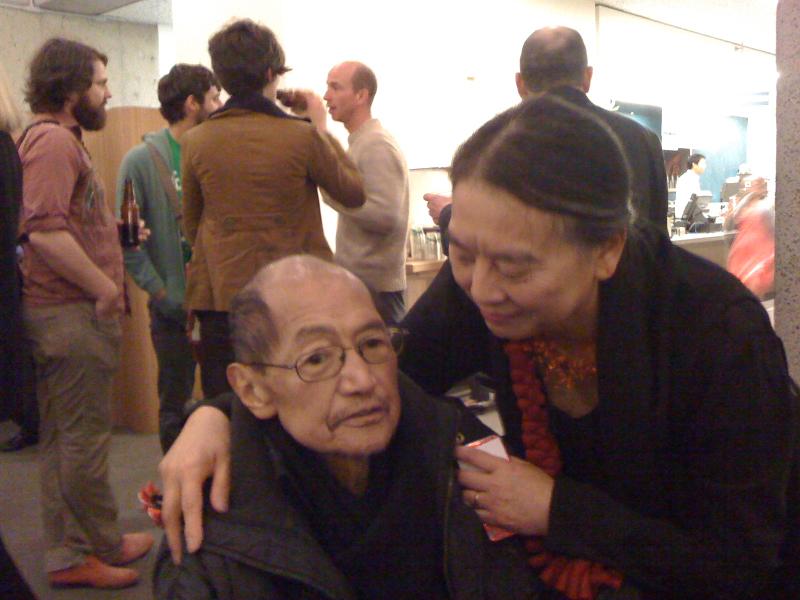 | |
And in loving memory of Carlos Villa ...
|
|
|
|
|
Recent Press for Hung Liu SF Chronicle Many contemporary painters struggle to get history into their work without looking pretentious or ideologically motivated. But big events of the late 20th century weighed so heavily on the life of Oakland painter Hung Liu that she might have found it difficult to keep history out of her work. - Kenneth Baker http://www.sfgate.com/default/article/2-Hung-Liu-showings-in-Oakland-4358054.php Square Cylinder It's easy to marvel at how Liu's mix of abstraction and realism draw us into the past. Yet virtuosity alone doesn't explain the emotional pull of her painting. So I'll venture a theory: Since Liu works from photos, her painting process is analogous to the photochemical act of "fixing" an image in the darkroom from which pictures seemingly emerge out of nowhere. Liu performs a kind of psychic translation of that act, supplementing it with lived experience and an extraordinary level of empathy. Result: she can paint from photos and literally "summon ghosts." - David Roth http://www.squarecylinder.com/2013/04/hung-liu-oakland-museum-of-california/ KQED Radio Hung Liu is good at summoning ghosts -- from memory and history. She's an Oakland artist born in China, and "Summoning Ghosts" is the title of a new retrospective of her work at the Oakland Museum of California. - Cy Musiker http://www.kqed.org/news/story/2013/03/28/118497/a_woman_who_can_summon_ghosts?category=bay+area Art-Rated Hung Liu is widely considered one of the most important Chinese artists working in America today. - Interview by Rachelle Reichert http://art-rated.com/?p=929 Art Practical The spare aesthetic of the exhibition currently on view at the Mills College Art Museum belies the fullness of the Bay Area artist and educator Hung Liu's major concern: history. - Ellen Tani http://www.artpractical.com/review/hung_liu_offerings/ Art Practical In February 1948, the artist Hung Liu was born in Changchun, in the far north of China. Only months later, the city was the site of a major siege by the People's Liberation Army. - Matthew Harrison Tedford http://www.artpractical.com/profile/hung_liu/ Contra Costa Times She's internationally known for her dramatic paintings, which often layer historical images with scenes from her own life or those of everyday people who didn't make it into the history books. - Angela Hill http://www.contracostatimes.com/breaking-news/ci_22664269/artist-hung-lius-work-blurs-history-memory San Francisco Chronicle/SFgate In the early 1970s, Hung Liu, who was being trained in the strict Social Realist style required of Chinese artists at the time, surreptitiously made small landscape paintings that contained no images of Chairman Mao, heroic soldiers or happy peasants. She hid them under her bed to dry. - Jesse Hamlin http://www.sfgate.com/entertainment/article/Hung-Liu-artistic-spirit-defied-Mao-4177946.php#ixzz2R8bgcIVu
|
|
Warm off the Press
 | |
Summoning Ghosts: The Art of Hung Liu
|
Essays by Wu Hung, Yiyun Li, Rene De Guzman, Karen Smith, Stephanie Hanor, Bill Berkson
216 pages
Oakland Museum of California & The University of California Press
|
Thank You!
Hung Liu Studio |
|
|
|